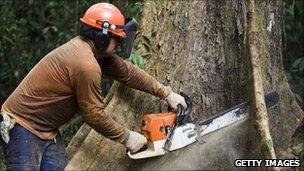Bankers take centre stage in fight to save rainforests
- Published

The idea behind international forestry conservation is making trees worth more standing than cut down
Given their obvious lack of qualifications, not to mention their recent track record, bankers don't immediately spring to mind as potential saviours of the rainforests.
Biologists, conservationists and ecologists may seem better suited, but in actual fact one of the most important tasks facing the world today may fall to financiers.
A scary thought perhaps, particularly in light of the global financial crisis brought about in part by excessive risk taking and dodgy synthetic investments dreamt up by over-zealous bankers, but one that is fast becoming reality.
For better or worse, there appears to be little choice.
'Front runner'
There should be no doubt about just how vital a function the world's rainforests perform. Not only do they play a key role in regulating global temperatures through carbon storage, but they are in essence responsible for the air we breath, the water we drink and many of medicines we rely on.
Preventing deforestation, through which an area of forest equivalent in size to the UK is cut down every two years, is not desirable, but essential for maintaining the earth's natural capital upon which the global economy relies.
In fact, the United Nations Environment Programme (UNEP) has calculated the current rate of deforestation needs to be halved by 2020 to prevent global temperatures rising to dangerous levels.
As Andrew Mitchell of the Global Canopy Programme puts it: "In the race against climate change, forests have come from nowhere to being a front runner."
Tackling deforestation, he says, is now seen as one of the "biggest, cheapest and quickest" ways of tackling rising temperatures.
Cash shortfall

Rainforests perform a hugely important role in the global ecosystem
Sixty-nine countries around the world have already signed up to the reduced emissions from deforestation and forest degradation programme, or REDD, under which forest owners are effectively paid not to cut down trees. About $5.5bn (£3.4bn) has been pledged by governments to the scheme already.
However, to reach its 2020 target, UNEP estimates that between $17bn and $30bn a year is needed. Governments alone cannot provide this kind of money.
"The problem cannot be solved without the private sector," Mr Mitchell says. Barring resistance from a few isolated participants, including most notably Bolivia, most people seem to agree with him.
In fact, last year a US government paper proposed that its $1bn contribution to REDD should be conditional on private sector support.
Market mechanisms, therefore, will be the key to REDD's success.
Open market
The theory is fairly straightforward. Private sector investors will fund REDD projects on the ground which, depending on their success, will generate carbon credits that can be sold on an open market.
And it's here where the bankers get involved. As Abyd Kamali, global head of carbon markets at Bank of America Merrill Lynch, explains: "Banks can play a very important role as financial intermediaries in terms of providing liquidity, risk management and structured finance".
At its most simple, this could involve helping to raise capital to fund REDD projects, which would involve an upfront capital payment with returns generated from carbon credits.
The key is establishing a trusted market for forestry credits. And here lies the biggest problem - there isn't one.
Without a workable, regulated market, investors will not be prepared to risk the kinds of capital needed to make REDD work.
Forest investments
A big step towards this goal should take place next year, when California is due to begin issuing forestry credits, but it could be many years before confidence in REDD carbon markets is high enough to attract sufficient funds.
This helps to explain why, as yet, only a handful of major banks, including Bank of America Merrill Lynch (BoA), BNP Paribas and Macquarie, are actively involved in REDD.

Stopping deforestation is now seen as one the best ways to slow global warming
There are a number of possible mechanisms through which banks can raise capital, some of which appear harmless; others less so. Some in fact do away with the need for carbon credits entirely, which means they can be launched more quickly.
One involves creating forest funds, where forestry carbon credits essentially become the underlying assets.
Another is what are loosely termed forestry bonds. Under one possible model, banks would issue bonds to raise funds that are then lent to governments to help preserve forests. The loan repayments would then form the income on the bond.
Another possibility, and one being piloted by BoA, is for a portion of the funds raised to be used to provide some kind of investment protection, with the balance used to invest in either carbon credits or other potentially revenue-generating services derived from forests, such as flood protection or genetic resources for drug development.
These kinds of vehicles may appear all too familiar to some.
"The financial sector can raise money very quickly - the sub-prime mortgage market proved this," says Chris Knight, assistant director of forestry and ecosystems at PricewaterhouseCoopers.
"Forest-backed bonds are not completely dissimilar to sub-prime vehicles [that rolled up US mortgages into investment funds and which helped trigger the global financial crisis when they unravelled]. It might be a way to raise funds."
He also points out that "one bank has a vested interest in securitisation [pooling assets to create investments]".
Raising taxes
Politicians and financiers are focusing heavily on REDD, yet there are other ways to help save the forests.
Banning unsustainable timber is one effective method, but the world's forests would be lost before enough trees were certified as sustainable, Mr Knight argues.
Reforming subsidies by transferring funds to more environmentally-friendly industries is another, says Mr Mitchell, as is raising taxes on commodities grown on deforested land, such as soya and palm oil.
Tax credits could even be introduced to encourage farmers to improve degraded land.
But it's unlikely these measures would be enough to reduce deforestation quickly enough.
This is why so many are pinning their hopes on REDD. And for REDD to work, serious amounts of money are needed. It's no surprise, therefore, that politicians and scientists are looking to bankers and private investors for the answers.
A sobering fact, perhaps, but the amount of money needed to make REDD work is nothing like the amount of money that was invested in sub-prime mortgages.
And besides, for now at least, there is no other realistic option on the table.
If bankers get it right, they will have played an important role in preserving one of the world's most important stores of natural capital.
If they get it wrong, the world's efforts to save the rainforests will be seriously undermined.
- Published9 January 2011
- Published12 October 2010
- Published21 October 2010
- Published24 October 2010